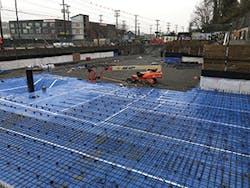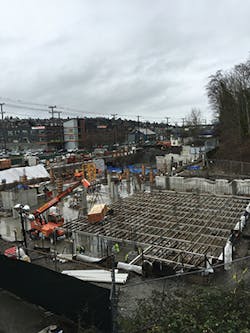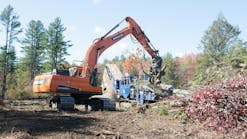The Interbay neighborhood of Seattle, WA, has a long history of industry. It is home to an 80-acre railway yard, the Port of Seattle’s commercial fishing fleet and cruise ship dock, a US military armory and storage facility with a long history of environmental concern, light industrial facilities, and miscellaneous retail and nearby residential properties. The neighborhood is environmentally sensitive as it’s bordered by Salmon Bay to the north and Elliot Bay to the south.
Recently, a 1.39-acre redevelopment project was permitted in the Interbay neighborhood. Construction of the six-story mini-storage warehouse structure began in 2017. When complete, it will contain approximately 260,000 square feet of total floor space with below-grade parking for 97 vehicles.
The property is in an area with several environmental concerns. It is located at the toe of a steep 40% slope and is within an archaeological buffer, liquefaction zone, and potential slide area as categorized by the City of Seattle. The site also sits on very stiff, silty clay overridden by shallow, soft slide debris. Along with slide hazards, the less-than-ideal soil conditions, and potential archaeological considerations, past industrial use of the area added another layer of complexity.
Historical uses of the project property included manufacturing of paint, varnish, and other coatings; printing activities; and onsite heating oil use. Due to the potential for environmental concerns, the project owner hired Environmental Partners Inc. (EPI) as the lead environmental consultant. Characterization data indicated that historical releases to soil and groundwater had occurred. The impacts were widespread across the redevelopment area.
The City of Seattle has previously allowed discharge of construction dewatering liquids to the sanitary sewer system, provided they met certain suspended solids and contaminant concentration criteria. Usually, a limited amount of settling or pretreatment was necessary prior to sanitary sewer discharge. However, the city recently halted this practice in certain geographic areas, and this project is located within one of these zones. Once the project team understood that discharge to the sanitary sewer was no longer allowed, a viable alternative for construction water disposal had to be determined quickly.
system
A review of alternative construction dewatering disposal options included offsite disposal via truck hauling and onsite treatment with release to the stormwater system. Financial and logistical concerns with both options created significant challenges. After consultation with multiple contractors, WaterTectonics was brought into the project team. Onsite treatment and release to the stormwater system were determined to be the best options.
EPI worked closely with WaterTectonics and the construction development team, which included Edwards Development, Sea Con LLC, and permit specialist Permits Northwest, to obtain a National Pollutant Discharge Elimination System (NPDES) permit for construction activities as site disturbance was greater than 1 acre. In Washington State, the NPDES program is administered by the Washington Department of Ecology (DOE), and the NPDES permit for construction activities is referred to as the Construction Stormwater General Permit, or CSWGP. As part of the notice of intent (NOI) or application for coverage under the CSWGP, known soil and groundwater contamination must be disclosed. Disclosure requires submittal of additional site data related to contamination as well as the methods that will be employed onsite to prevent the release of contaminants of concern into waters of the state. Once this additional information is provided, an administrative order (AO) is issued along with general permit coverage. The AO prescribes specific stormwater handling methods and additional water-quality sampling and analyses to ensure compliance with state water-quality standards.
WaterTectonics had been involved on other urban redevelopment projects in the area with similar groundwater and soil contamination issues. These projects had been subject to AO constraints as well, so WaterTectonics was familiar with the additional information required for submittal, subsequent sampling, and management during construction.
After reviewing details with the project team, WaterTectonics went to work designing a treatment system that would not only meet the standard CSWGP turbidity and pH requirements—25 nephelometric turbidity units (NTU) and 6.5 to 8.5, respectively—but also treat for compounds indicated in the AO. These additional compounds included total petroleum hydrocarbons (TPH) including gas and diesel range organics; polycyclic aromatic hydrocarbons (PAH); carcinogenic polycyclic aromatic hydrocarbons (cPAH); metals (arsenic, cadmium, chromium, lead); and volatile organic compounds (trichloroethylene, vinyl chloride, and BTEX) along with the pesticides chlordane and 4,4-DDT.
The treatment process that WaterTectonics defined for incorporation consisted of turbidity reduction, both for permit compliance and pretreatment for final polishing filtration; pH neutralization of high-pH stormwater from concrete exposure; aeration for volatile organic compound (VOC) reduction; and granulated activated carbon (GAC) for removal of PAHs, TPH, pesticides, and any remaining VOCs.
The 100-gallon-per-minute treatment process designed by WaterTectonics consisted of one primary detention tank, an electrocoagulation (EC) unit for turbidity and metals reduction, one settling tank, three pod sand filtration units, and final polishing with three GAC vessels in lead-lag configuration. The EC process has a general use level designation (GULD) issued by the Washington DOE for use on construction sites. While there are a number of liquid chemicals that carry GULD approvals, EC was chosen as its GULD allows continuous operation without onsite labor as long as the remote notification package is enabled. Because groundwater dewatering would occur 24/7, EC was the technology chosen. The EC system monitors turbidity and pH prior to final discharge through the GAC, which prevents discharge of out-of-spec water while also preventing premature blinding of the GAC should a system upset occur.
Sea Con LLC, the project general contractor, prepared a 1,500-square-foot level pad for the detention and active treatment system equipment. Groundwater and site stormwater were directed to the primary detention tank. Initially, the system was operated in batches to prove that the process produced effluent that met the AO discharge limits. After successfully treating two consecutive batches and authorization from DOE, the system was switched to automated flow-through mode. Once the system was operating in an automatic mode, Sea Con installed pumps throughout the site that continuously transferred construction water to the treatment system. Even with a historically wet winter, the treatment system was able to keep pace with the construction dewatering activities. This allowed earthwork and concrete activities to continue unimpeded through the winter season. To ensure compliance with the DOE standards, analytical samples were and continue to be taken weekly, confirming discharge requirements are being met.
Management of site BMPs is still required even with an active treatment system onsite. Sea Con has been consistent with BMP upgrades and maintenance but chose to bring in WaterTectonics’ certified erosion and sediment control leads (CESCLs) to perform weekly site inspections as required by DOE’s NPDES permit. Inspections include a full evaluation of current construction-site BMPs, water-quality sampling, and site visit summary reports. Monthly discharge monitoring reports were filed with DOE as part of this service as well.
To date, water discharged from the site has met CSWGP/AO standards. As earthwork activities wrap up and the project moves into vertical development, the active treatment system will be scaled back to save both expenses and construction space. Influent water-quality testing will dictate the ability to remove treatment components as the pathways of exposure are eliminated.
Without active treatment and a thoughtful construction management team, this project would have been delayed at best or worse, completely shelved. The mix of poor site soils, widespread contamination, environmentally critical areas, and last-minute regulatory changes made redevelopment a significant challenge. With the project team working together toward common goals, this project has continued on schedule and on budget.




